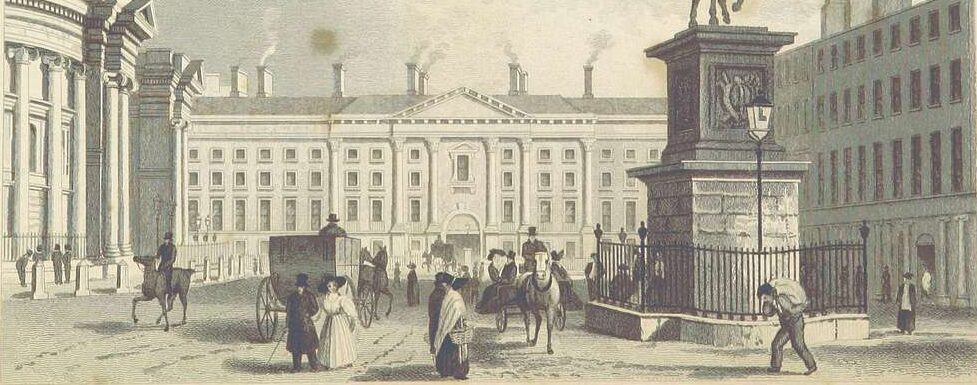Seán Patrick Donlan, University of Limerick, has published Remembering: Legal Hybridity and Legal History in the Comparative Law Review, June 2011. Here is the abstract.
An interest in contemporary, comparative legal and normative hybridity, or, “legal pluralism,” around the globe has become increasingly common. But the hybridity of our own Western past, and the significance of this fact, is too often ignored.As part of a wider project on, “hybridity and diffusion,” the mixtures and movements of state law and other norms, this article contributes to the process of ‘remembering’ this past. It does so to better prepare comparatists for the challenges of the present.
Author: Eoin
New Irish law on the liability of good Samaritans « A Clatter of the Law
The 2011 Act essentially provides that good Samaritans will not be personally liable for anything done while assisting someone ill, injured or in danger. Volunteers will be similarly protected from liability when carrying out volunteer work. Of course, there are exceptions and, for example, the protection from liability is lost in the case of malice or gross negligence.
The changes do not introduce into Irish law a duty to intervene. This is in line with the recommendations of the Law Reform Commission, who concluded that, in Irish society, the duty to intervene was of a moral rather than legal quality and essentially should remain that way.
More on the judicial pay referendum
Fiona de Londras: The Judicial Pay Amendment: Why I will be Voting ‘No’
Sandeep Gopolan: New Draft Article for Judges’ Pay Cut Referendum
Ronan Kennedy: Separation of powers or an industrial relations dispute?…
Freedom of Contract – In Ireland
The MultiText Project in History is an innovative educational project, undertaken by the History Department, University College Cork, to provide resources for students of Modern Irish History at all levels. The following arresting image is available on their website:
 |
MultiText’s source for the image is the Weekly Freeman for 25 February 1882, and they comment that “the unequal nature of the landlord/tenant relationship was a major cause of the land war” (a period of civil unrest in rural Ireland in the latter half of the nineteenth century, ultimately defused by a series of Land Acts between 1870 and 1903).
The image shows an unhappy tenant seated at a table, unwillingly signing a lease. Under the table can be seen a notice to increase rent and a notice to quit. At the top are two inset images, one of John Bull, the other of a destitute family heading for the workhouse. The tenant is surrounded by three grim-looking men. One has a bill for outstanding rent in his pocket, and he is brandishing an eviction decree. Another brandishes a cudgel of some sort. The third is stabbing his finger at the lease.
The caption along the bottom reads: Freedom of Contract – In Ireland.…
Not by higher education alone?
 The Bible tells Christians that ‘Man does not live on bread alone, but on every word that comes from the mouth of God’ (Matthew 4:4). The aphorism is echoed in the title and plot of Vladimir Dudintsev’s anti-Stalist novel Not by Bread Alone. Now it is the main title of a recent book about the importance of higher education in developing modern societies built upon the fundamental values of democracy, human rights and the rule of law: Sjur Bergan Not by bread alone (Council of Europe higher education series No 17; 2011). Public debate often assumes that the only purpose of higher education is to prepare gradutes for employment, and this view feeds back into third-level entry requirements and second-level curricula. Hence, we see an increasing focus on “training” (rather than educating) graduates in science, technology, engineering, and mathematics (with attendant risks to the arts, humanities, and social sciences). This third-level policy brings a concommitant focus at second-level on bonus CAO points for maths generating calls for bonus points for science and a compulsory leaving certificate science course (perhaps to the detriment of the study of foreign languages; and quite how this stands with the Minster for Education’s stated aim of moving away from the CAO points culture is unclear).…
The Bible tells Christians that ‘Man does not live on bread alone, but on every word that comes from the mouth of God’ (Matthew 4:4). The aphorism is echoed in the title and plot of Vladimir Dudintsev’s anti-Stalist novel Not by Bread Alone. Now it is the main title of a recent book about the importance of higher education in developing modern societies built upon the fundamental values of democracy, human rights and the rule of law: Sjur Bergan Not by bread alone (Council of Europe higher education series No 17; 2011). Public debate often assumes that the only purpose of higher education is to prepare gradutes for employment, and this view feeds back into third-level entry requirements and second-level curricula. Hence, we see an increasing focus on “training” (rather than educating) graduates in science, technology, engineering, and mathematics (with attendant risks to the arts, humanities, and social sciences). This third-level policy brings a concommitant focus at second-level on bonus CAO points for maths generating calls for bonus points for science and a compulsory leaving certificate science course (perhaps to the detriment of the study of foreign languages; and quite how this stands with the Minster for Education’s stated aim of moving away from the CAO points culture is unclear).…
The Margin of Appreciation in the ECHR
 The ever-informative ECHR blog brings news of an interesting article on the margin of appreciation jurisprudence of the European Convention on Human Rights (which has been examined on this blog here and here). It is the doctrine by which the ECHR affords Members States some initial latitude to assess the impact of a restriction upon a Convention right; the Court takes the view that national authorities are usually better placed to determine the particular circumstances of an individual case; and it often shows greater forebearance where important national interests and diverse social and moral convictions are at stake. But it is a doctrine developed by the Court itself rather than one rooted in the text of the Convention, and it is a deeply contentious issue. The article traces the debates surrounding the doctrine, and locates them in a current complex social, cultural and religous controversy.
The ever-informative ECHR blog brings news of an interesting article on the margin of appreciation jurisprudence of the European Convention on Human Rights (which has been examined on this blog here and here). It is the doctrine by which the ECHR affords Members States some initial latitude to assess the impact of a restriction upon a Convention right; the Court takes the view that national authorities are usually better placed to determine the particular circumstances of an individual case; and it often shows greater forebearance where important national interests and diverse social and moral convictions are at stake. But it is a doctrine developed by the Court itself rather than one rooted in the text of the Convention, and it is a deeply contentious issue. The article traces the debates surrounding the doctrine, and locates them in a current complex social, cultural and religous controversy.
From the introduction and the conclusion:
…Raffaella Nigro “The Margin of Appreciation Doctrine and the Case-Law of the European Court of Human Rights on the Islamic Veil” (2010) 11 (4) Human Rights Review 531-564
In its judicial activity, the European Court of Human Rights increasingly resorts to the margin of appreciation doctrine as a means of granting States the discretionary power to adopt, both positive steps to comply with the European Convention on Human Rights and steps which, although interfering with some of the rights and freedoms sanctioned by it, are considered to be justifiable because they are necessary to preserve public order and/or to protect the rights and freedoms of others in a democratic society.
A devastating analysis of the proposed wording of the judicial pay amendment by @extemporeblog
Some extracts from a longer and fascinating post:
First, the proposed wording does not restrict the permissible justifications for a pay-cut in any serious way. …
Second, the proposed wording contains no apparent constraint on the “classes” of other public servants whose pay must be reduced to permit a judicial pay-cut. ….
Third, on a literal reading, the wording doesn’t require any equivalence or proportionality between the pay-cuts for other public servants and the judicial pay-cut. If that’s right, the government could impose a 1% cut to the salaries of TDs and Senators, and follow it up with a 50% cut to judges’ salaries.
Fourth, the proposal doesn’t provide a role for any independent body in determining whether a judicial pay-cut is justified. …
Judicial pay referendum
Two stories in today’s papers caught my eye; here are some extracts:
JUDGES’ PAY PROPOSED AMENDMENTS
THE GOVERNMENT is proposing that Article 35.5 of the Constitution be amended by substituting the following:
“35.5.1 The remuneration of judges shall not be reduced during their continuance in office save in accordance with this section.
35.5.2 The remuneration of judges is subject to the imposition of taxes, levies or other charges that are imposed by law on persons generally or persons belonging to a particular class.
35.5.3 Where, before or after the enactment into law of this section, reductions have been or are made by law to the remuneration of persons belonging to classes of persons whose remuneration is paid out of public money and such law states that those reductions are in the public interest, provision may also be made by law to make reductions to the remuneration of judges.”
SENIOR JUDGES FACING RUIN FROM POOR INVESTMENTS
A NUMBER of senior judges who suffered huge losses from ill-fated property investments and a meltdown in bank shares face financial ruin, the Irish Independent has learned.
Financial experts have advised up to 10 members of the judiciary that they will not be able to meet their financial commitments.
